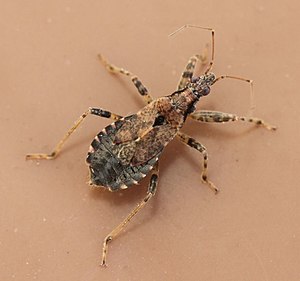Himacerus mirmicoides
| Himacerus mirmicoides | ||||||||||||
|---|---|---|---|---|---|---|---|---|---|---|---|---|

Himacerus mirmicoides |
||||||||||||
| Systematics | ||||||||||||
|
||||||||||||
| Scientific name | ||||||||||||
| Himacerus mirmicoides | ||||||||||||
| ( O. Costa , 1834) |
Himacerus mirmicoides ( Syn .: Nabis mirmicoides ) is an insect belongingto the family of sickle bugs (Nabidae)within the subordination of bugs (Heteroptera). Because of the similarity of its nymphs to ants , the bug is commonly referred to as the sickle bug bug. The Greek epithet mirmicoides also meansant-like.
Distribution and habitats
The bug is common all over Europe with the exception of the extreme north. In the south it occurs as far as North Africa, in the southeast as far as the Caucasus . In Germany, the bug is much less common to the north. In the south and in Austria it occurs very frequently in places. In the Alps , it lives at altitudes of around 1,300 meters above sea level.
The animals inhabit very different biotopes. They live in dry, warm and open locations with a low herbaceous layer , as well as in moist places shaded by woody plants. In Northern Germany it only settles in locations with less heat.
Features and way of life
The adult sickle bugs ( imagines ) reach body lengths between 7 and 8.7 millimeters and are therefore significantly smaller than the very similar tree sickle bug ( Himacerus apterus ). The basic color is dark brown to reddish. The antennae are significantly shorter than the body. The hemi-vertebrae are shortened to varying degrees, but always longer than in H. apterus . The membranes of the forewings are darkly spotted, as are the light legs. The corium is mostly reddish in color. The wings are rarely of normal length. The abdomen of both sexes is somewhat widened with often lighter spots on each segment of the abdominal margin ( connexive ), which is also slightly curved upwards. The outer appearance of the dark larvae resembles ants. In older larvae, this impression is reinforced by two white spots on the base of the abdomen, which simulate an ants' waist. It has not yet been clearly established whether there is a specific relationship with ants.
The sickle bugs feed exclusively on predatory insects and other arthropods . There seems to be no preference for certain prey animals. They hunt around on the ground, but are also in search of food in the crowns of deciduous and coniferous trees. The adults are most often found in the shrub layers.
The bugs hibernate in the adult stage in dry and sheltered places. In spring, eggs are laid in plant stems from April. The larvae can be found all summer. The adult animals of the new generation appear from late July or early August.
literature
- E. Wachmann, A. Melber & J. Deckert: Bugs. Volume 1: Dipsocoromorpha, Nepomorpha, Gerromorpha, Leptopodomorpha, Cimicomorpha (Part 1), revision of the bugs in Germany, Austria and German-speaking Switzerland, Goecke & Evers, Keltern, 2006. ISBN 3-931374-49-1
- Ekkehard Wachmann: watch bugs - get to know. Neumann-Neudamm, Melsungen, 1989, ISBN 3-7888-0554-4
Web links
- www.naturbildarchiv-guenter.de Picture story on the way of life and developmental biology of the sickle bug Himacerus mirmicoides
- Himacerus (Aptus) mirmicoides in Fauna Europaea
